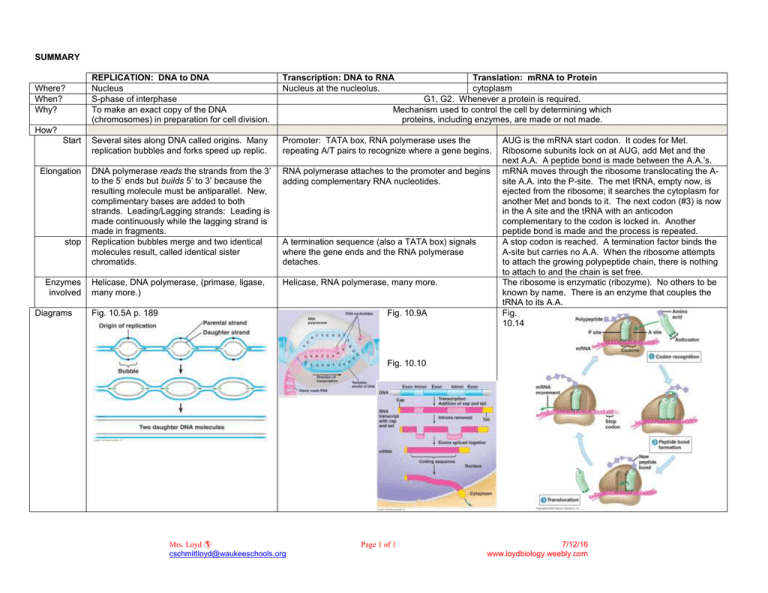SUMMARY REPLICATION: DNA to DNA Transcription: DNA to RNA
advertisement

SUMMARY Where? When? Why? REPLICATION: DNA to DNA Nucleus S-phase of interphase To make an exact copy of the DNA (chromosomes) in preparation for cell division. Transcription: DNA to RNA Nucleus at the nucleolus. Translation: mRNA to Protein cytoplasm G1, G2. Whenever a protein is required. Mechanism used to control the cell by determining which proteins, including enzymes, are made or not made. Several sites along DNA called origins. Many replication bubbles and forks speed up replic. Promoter: TATA box, RNA polymerase uses the repeating A/T pairs to recognize where a gene begins. DNA polymerase reads the strands from the 3’ to the 5’ ends but builds 5’ to 3’ because the resulting molecule must be antiparallel. New, complimentary bases are added to both strands. Leading/Lagging strands: Leading is made continuously while the lagging strand is made in fragments. Replication bubbles merge and two identical molecules result, called identical sister chromatids. RNA polymerase attaches to the promoter and begins adding complementary RNA nucleotides. Helicase, DNA polymerase, (primase, ligase, many more.) Helicase, RNA polymerase, many more. How? Start Elongation stop Enzymes involved Diagrams A termination sequence (also a TATA box) signals where the gene ends and the RNA polymerase detaches. Fig. 10.5A p. 189 Fig. 10.9A AUG is the mRNA start codon. It codes for Met. Ribosome subunits lock on at AUG, add Met and the next A.A. A peptide bond is made between the A.A.’s. mRNA moves through the ribosome translocating the Asite A.A. into the P-site. The met tRNA, empty now, is ejected from the ribosome; it searches the cytoplasm for another Met and bonds to it. The next codon (#3) is now in the A site and the tRNA with an anticodon complementary to the codon is locked in. Another peptide bond is made and the process is repeated. A stop codon is reached. A termination factor binds the A-site but carries no A.A. When the ribosome attempts to attach the growing polypeptide chain, there is nothing to attach to and the chain is set free. The ribosome is enzymatic (ribozyme). No others to be known by name. There is an enzyme that couples the tRNA to its A.A. Fig. 10.14 Fig. 10.10 Mrs. Loyd cschmittloyd@waukeeschools.org Page 1 of 1 7/12/16 www.loydbiology.weebly.com




